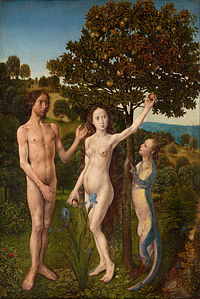art.wikisort.org - Painting
The Vienna Diptych or the Fall and Redemption of Man[1] is a religious diptych by the Flemish artist Hugo van der Goes depicting the fall of man on the left panel and the lamentation of Christ on the right panel. Painted in the second half of the 15th century, the diptych is housed in the Kunsthistorisches Museum, Vienna.[1]
The tempting Serpent is depicted as a bipedal salamander-like creature because it was assumed that the serpent could walk before God's curse compelled it to crawl and eat dust.[2] The human-headed Serpent was introduced into art in the late 13th century.[2] Subsequent Renaissance artists generally abandoned the depiction of Serpent as a human-headed creature.[2]
The reverse side of the left panel has an image of Saint Genevieve painted on it.[3] The reverse side of the right panel bears traces of a coat of arms, consisting of a shield with a black eagle and two supporters, of which only the feet survived.[3] The coat of arms was painted in the 17th century and indicates possible House of Habsburg ownership of the diptych.[3]
References
- "Goes, Hugo van der – Vienna Diptych". Van Pelt Library. Retrieved 1 February 2015.
- Koch, Robert A. (1965). "The Salamander in Van der Goes' Garden of Eden". Journal of the Warburg and Courtauld Institutes. 28 (1): 323–326 [323]. doi:10.2307/750680. JSTOR 750680. S2CID 195042873.
- Trowbridge, Mark (2011). "Sin and Redemption in Late-Medieval Art and Theater: The Magdalen as Role Model in Hugo van der Goes's Vienna Diptych". In Sarah Blick; Laura Deborah Gelfand (eds.). Push Me, Pull You: Imaginative, Emotional, Physical, and Spatial Interaction in Late Medieval and Renaissance Art. Brill. pp. 415–445 [444]. doi:10.1163/9789004215139_013. ISBN 978-9004205734.
На других языках
[de] Wiener Diptychon
Das Wiener Diptychon ist ein Gemälde von Hugo van der Goes. Der linke Flügel des wahrscheinlich 1477 mit Öl auf Eiche gemalten Bildes misst 32,3 × 21,9 cm, der rechte 34,4 × 21,9 cm. Das Diptychon befindet sich im Kunsthistorischen Museum in Wien.- [en] Vienna Diptych
[fr] Diptyque de Vienne
Le Diptyque de Vienne ou La Chute et la Rédemption de l'Homme est un diptyque religieux de l'artiste primitif flamand Hugo van der Goes représentant la Chute de l'Homme sur le panneau de gauche et la Déploration du Christ sur le panneau de droite. Peint dans la seconde moitié du XVe siècle, le diptyque est conservé au Musée d'Histoire de l'art de Vienne.[it] Dittico di Vienna
Il Dittico di Vienna, chiamato anche Peccato originale e deposizione o Dittico della caduta e redenzione dell'uomo, è un dipinto del pittore fiammingo Hugo van der Goes realizzato circa nel 1479 e conservato nel Kunsthistorisches Museum di Vienna.[ru] Грехопадение (картина ван дер Гуса)
«Грехопадение» (нидерл. De zondeval) — картина фламандского живописца Гуго ван дер Гуса (1430/40–1482), представителя эпохи Раннего Возрождения. Создана в 1479 году. Хранится в Музее истории искусств в Вене (инв. №GG 5822).Другой контент может иметь иную лицензию. Перед использованием материалов сайта WikiSort.org внимательно изучите правила лицензирования конкретных элементов наполнения сайта.
WikiSort.org - проект по пересортировке и дополнению контента Википедии

